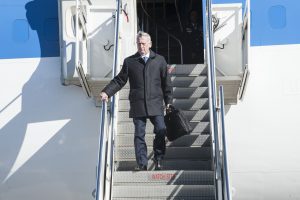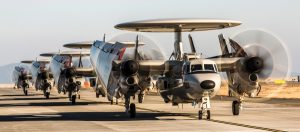2017-02-03 With all the global discussion about Trump and allies, a key development seems to have been missed — the reinforcement of the US-Japanese relationship and the arrival of new capabilities for the extended defense of Japan and of U.S. Pacific allies.
First, the F-35Bs arrived at Iwakuni earlier this month.
Second, the advanced Hawkeyes have joined them and together will constitute a significant expansion of maritime domain awareness strike capabilities.
U.S. Navy E-2D Advanced Hawkeyes with Carrier Airborne Early Warning Squadron fly in a “V” formation and land at Marine Corps Air Station Iwakuni, Japan, Feb. 2, 2017. VAW-125 arrived at MCAS Iwakuni from Naval Station Norfolk, Va.
The E-2D Advanced Hawkeye is equipped with the most advanced airborne radar in the world, possessing systems which increase the capabilities to defend Japan and provide security in the Indo-Asia-Pacific region.
Advanced Hawkeyes at MCAS Iwakuni from SldInfo.com on Vimeo.
In a story published February 2, 2017 in Stars and Stripes by Tyler Hlavc, this development was discussed.
The Navy bolstered its airborne radar and detection capabilities in the Pacific with the Thursday arrival of Carrier Airborne Early Warning Squadron 125 at Marine Corps Air Station Iwakuni, Japan.
VAW-125’s presence signifies a shift for the Navy as it continues relocating the bulk of Carrier Air Wing 5 — the USS Ronald Reagan’s aviation wing — from Naval Air Station Atsugi, southwest of Tokyo. The squadron flies the new E-2D Advanced Hawkeye early warning and control aircraft, the latest variant of the E-2 Hawkeye series.
The E-2D “employs long-range radar and electronic communications capabilities to oversee the battle space and detect threats beyond the sensor range of other friendly units,” said a Navy statement that described the aircraft as the “digital quarterback” of the fleet.
New features include an AN-APY9 radar capable of both mechanical and electronic sweeping. The new radar has been touted in defense journals for its potential to detect stealth aircraft.
The aircraft also includes an “all glass” tactical cockpit and an upgraded mission computer and data-link capabilities, the statement said.
Hawkeyes are the Navy’s longest-serving carrier-based aircraft.
Congress appropriated $12.5 billion last year for the first 40 E-2D models; the Pentagon is requesting another $9.5 billion for 35 more new Hawkeyes in future years, according to the Center for Strategic and Budgetary Assessments, a nonpartisan policy institute.
 Defense Secretary Jim Mattis arrives at Yokota Air Base Japan. While in Japan, Secretary Mattis met with the Japanese minister of defense Tomomi Inada during his first overseas tour as SECDEF. (U.S. Navy photos by Petty Officer 2nd Class Marcus Castaneda)
Defense Secretary Jim Mattis arrives at Yokota Air Base Japan. While in Japan, Secretary Mattis met with the Japanese minister of defense Tomomi Inada during his first overseas tour as SECDEF. (U.S. Navy photos by Petty Officer 2nd Class Marcus Castaneda)
The Japan Air Self-Defense Force also plans to use the new Hawkeye to help monitor foreign aircraft approaching their airspace, including those from China and Russia.
The Defense Ministry should acquire four E-2D Advanced Hawkeyes by March 2019, a spokesman told Stars and Stripes.
Those aircraft will be used to conduct early warning and surveillance missions, including near the Japan-administered Senkaku Islands, which China claims as its own, the spokesman said.
Stars and Stripes reporter Hana Kusumoto contributed to this report.
https://www.stripes.com/news/navy-upgrades-pacific-carrier-wing-with-new-e-2d-hawkeye-1.452102
It should also be noted that the first overseas visit of the new Sec Def has been to Japan.
Recently, the Japanese Prime Minister made an important visit with Pacific allies enhancing capabilities to deal with evolving threats in the region.
 Advanced Hawkeyes come to MCAS Iwakuni. Credit: USMC
Advanced Hawkeyes come to MCAS Iwakuni. Credit: USMC
And with Prime Minister Abe due to visit the United States next week, the Japanese government announced that it was going to invest significantly in the rebuilding of US infrastructure as well through its pension funds.
According to an article published by The Japan Times, “Japan plans to use its public pension fund to invest in U.S. infrastructure development, a source from the government said Thursday.
“The investment drive is part of a wide-ranging policy package Prime Minister Shinzo Abe is expected to present to U.S. President Donald Trump during their highly anticipated summit in Washington on Feb. 10.
“Without citing sources, the Nikkei business daily said the Government Pension Investment Fund, the world’s largest, will buy debt issued by U.S. companies to fund the vast spending program.
“In addition to infrastructure, it is hoped the package will lead to the creation of several hundreds of thousands of U.S. jobs in projects related to artificial intelligence and robotics, according to people familiar with the matter.”
“Given the state of the Chinese economy and the uncertainty of the Euro, this would seem to be a good idea.
MCAS IWAKUNI, YAMAGUCHI, JAPAN
Video by Cpl. Waiyan Tin
02.02.2017

